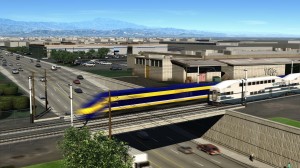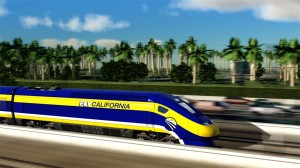I’ve been a bit harsh on California’s high speed rail planners. It’s hard not to be: the route is gerrymandered to satisfy political interests, which has undermined its fiscal attractiveness and created a deep financial hole to build anything of use. The twisted route has also reduced its utility for residents in California’s major population centers, while adding to the construction costs.
Meanwhile, the current financial projections simply don’t anticipate enough funding to build anything but possibly a San Jose to Bakersfield connection. Last I checked, few people in California thought those cities were priorities for the state to connect, especially given that Bakersfield already has a pretty successful Amtrak connection to the Bay Area.
 But in some ways, high speed rail has been unfairly victimized so far by our polarized political environment. Most rail systems, at least of the intra-city type, usually start with a local political consensus and then funding stream, which gets matched by federal support.
But in some ways, high speed rail has been unfairly victimized so far by our polarized political environment. Most rail systems, at least of the intra-city type, usually start with a local political consensus and then funding stream, which gets matched by federal support.
During the height of federal support for rail transit in the 1960s and 1970s, local and/or state governments only had to provide 20 percent of the funds, with the federal government paying an astounding 80 percent of the costs (astounding for transit — the feds routinely pay 90 or even 100 percent of the costs of many highway projects).
That deal became less sweet by the 1980s, when the Reagan administration got the federal match down to 50 percent, as Los Angeles experienced when that region got its Metro Rail going (as I chronicled in the book Railtown). But still, 50 percent is pretty good, even if it’s stiffing urban taxpayers who disproportionately contribute transportation taxes to the U.S. government but see less return.
With high speed rail, it could have been a similar story: a statewide consensus on route and funding stream came together in 2008 with a successful $10 billion bond issue passed by the voters. Since then, the governor and legislature have committed a substantial amount of cap-and-trade funds, which could add another $5 and possibly $10 billion or more by 2020.
 But with these possible $20 billion in state funds, the federal government has only committed $3.5 billion in matching dollars to date. That’s hardly the 50% match that the federal government typically spends.
But with these possible $20 billion in state funds, the federal government has only committed $3.5 billion in matching dollars to date. That’s hardly the 50% match that the federal government typically spends.
At that percentage, the federal government would have to kick in $20 billion total (a fraction of the $2 trillion spent on recent wars in the Middle East, for example). Then the system would have enough dollars to get solidly to San Francisco or perhaps to Los Angeles.
But the U.S. Congress is polarized against high speed rail and unwilling to spend much money on non-automobile modes of transportation, due to Republican resistance. And that dynamic has been in place since the Tea Party election of 2010.
All of this may explain why the high speed rail business plan has been criticized by state oversight agencies for not “showing us the money” on these initial construction phases. The reality is that high speed rail doesn’t have the money. And it won’t until Congress changes.
But given that high speed rail is a long-term, multi-decade process, the system’s backers may have a shot at waiting things out until another wave election or change in the political environment occurs. In short: the plan is to pray for a better congress.
But you can’t exactly write that in a business plan.
Leave a Reply
You must be logged in to post a comment.


